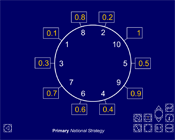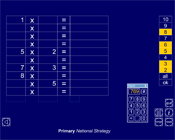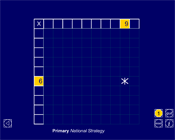Teaching guidance
This teaching guidance document suggests some of the key vocabulary, models, images and practical equipment that children should experience and be able to use. It also includes some teaching tips to provide a few starting points for ways of supporting children with this area of mathematics.
 Can I use my tables to multiply and divide? - teaching guidance | 80KB
Can I use my tables to multiply and divide? - teaching guidance | 80KB 
Consolidation and practice
These resources are to support children in guided or independent work. Roll over the highlighted resources for a description.
Number dials

This interactive teaching program (ITP) is an ICT-based tool to support the exploration and recall of multiplication and division facts. Number dials ITP allows the child or teacher to generate sets of products of a central number and numbers from 1 to 10. The ITP can be used to practise multiplying and dividing by one-digit and two-digit whole numbers and decimals.
Multiplication tables

This interactive teaching program (ITP) is an ICT-based tool to support the exploration of multiplication facts. Multiplication tables ITP allows the child or teacher to set up one or more multiplication tables, hiding or revealing either of the factors or the product. Decimal numbers can be explored using the keypad.
Multiplication board

This interactive teaching program (ITP) is an ICT-based tool to support the exploration of multiplication and division facts. Multiplication board ITP allows the child or teacher to represent the product of two numbers as an array, displaying the product and factors.
Opportunities to use and apply
Possible contexts include:
- solving simple problems involving ratio and proportion, e.g. At the gym club there are two boys for every three girls. There are 30 children in the club. How many boys are there?
- relating division and fractions, e.g. Knowing 1/3 of 24 is equivalent to 24 ÷ 3.
- finding fractions of numbers and quantities, e.g. What is 4/5 of 35?
- using factors, e.g. Working out 90 ÷ 6 by dividing 90 by three and dividing the resulting quotient by two.
- area and perimeter, e.g. The perimeter of an equilateral triangle is 120 cm. How long is each side?
Confirming learning
Ask probing questions such as:
- Describe some connections between 6, 7 and 42, using the words multiple and factor.
- Write three different multiplications with a product of 40.
- Write three different divisions with a quotient of nine.
- If you multiply me by three, you will get 24. What number am I?
- Multiples of six end in 0, 2, 4, 6 or 8. Is this statement true or false?
- Multiples of seven are all even. True or false? How do you know?
- Name all the multiples of nine between 80 and 100.
- Name three numbers that are multiples of six as well as multiples of five.
 Calculating
Calculating


